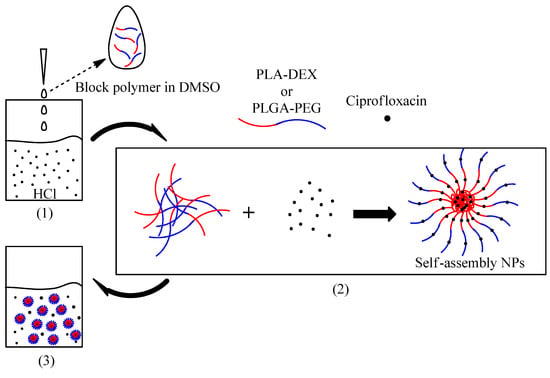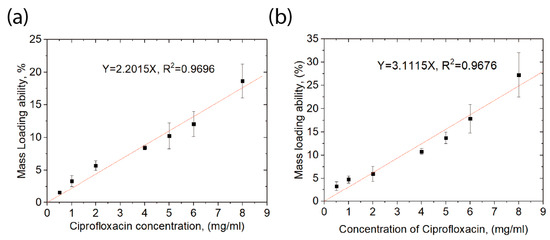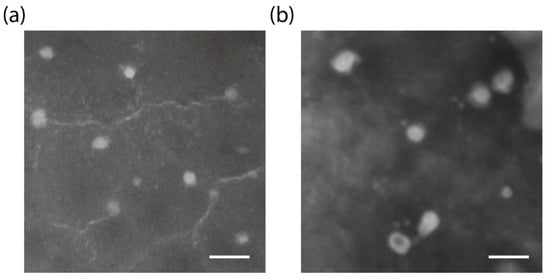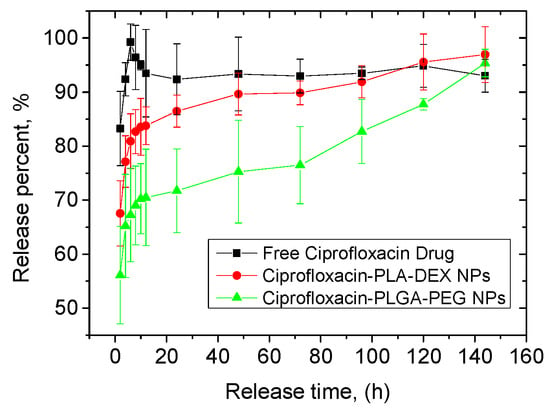Abstract
The improvement of the loading content of hydrophilic drugs by polymer nanoparticles (NPs) recently has received increased attention from the field of controlled release. We developed a novel, simply modified, drop-wise nanoprecipitation method which separated hydrophilic drugs and polymers into aqueous phase (continuous phase) and organic phase (dispersed phase), both individually and involving a mixing process. Using this method, we produced ciprofloxacin-loaded NPs by Poly (d,l-lactic acid)-Dextran (PLA-DEX) and Poly lactic acid-co-glycolic acid-Polyethylene glycol (PLGA-PEG) successfully, with a considerable drug-loading ability up to 27.2 wt% and an in vitro sustained release for up to six days. Drug content with NPs can be precisely tuned by changing the initial drug feed concentration of ciprofloxacin. These studies suggest that this modified nanoprecipitation method is a rapid, facile, and reproducible technique for making nano-scale drug delivery carriers with high drug-loading abilities
1. Introduction
Since its introduction in the late 1980s by Fessi et al. [1], nanoprecipitation technology has grown into a highly efficient, easily handled, and mature tool to fabricate drug-loaded nanoparticles (NPs) for biomedical researchers. Polymer and hydrophobic drugs were dissolved in the same organic solvents and then mixed with an aqueous solution. By modifying the solution mixing speed, Oil/Water ratio [2], pH [3], polymer/drug ratio [4], block ratio of block polymers [5], and solvent selection [6], the parameters of NPs including size, distribution, and drug encapsulation efficiency can be tuned easily. We previously reported on the encapsulation of the hydrophobic drug ellipticine by using peptide molecules [7,8].
However, the conventional nanoprecipitation procedure has relatively limited potential to encapsulate hydrophilic compounds [9]. This deficiency of encapsulation is mainly due to poor solubility of hydrophilic compounds in most organic solvents [10,11,12,13,14]; it further affects its controllability over drug-loading amount [15]. Efforts have been made to improve the state; however, these involve complex preparation processes, including O/W and W/O/W emulsion methods [16] as well as hydrogel [17], resulting in much larger non-uniform nanoparticles, with sizes from several hundred to several thousand nanometers [18]. Classical nanoparticles methods lead to mass loading of approximately 1 wt% [19].
In this study, we chose ciprofloxacin as our model drug, one of the most commonly used anti-infective agents for ocular treatment because of its low toxicity, broad-spectrum antimicrobial activity, and low resistance to bacteria [20]. Previous research on ciprofloxacin encapsulation have largely been conducted with emulsion methods [16] or hydrogels [17], which usually involved complex preparations or led to much larger and polydisperse NPs. For example, emulsion methods require a homogenization process, which takes a long time to mix; additionally, residue of toxic organic phases can be a potential challenge for biocompatibility. Here, we developed a modified nanoprecipitation method that separates drug and polymer into two different organic and aqueous phases. Monodispersed, ciprofloxacin-loaded NPs were formed with a tunable size via a simple drop-wise mixing process similar to conventional nanoprecipitation’s [9]. The drug encapsulation efficiencies of NPs and their in vitro release kinetics were assessed. In addition, a high linear correlation was found between the initial concentration of ciprofloxacin and the mass-loading ability of PLA-DEX and PLGA-PEG NPs. This work provides a new quantitative approach for producing polymeric NPs with high-loading capability of hydrophilic drugs through a simple, one-step nanoprecipitation.
2. Experimental Section
2.1. Materials
Poly (d,l-lactic acid)-Dextran (PLA20kDa-DEX10kDa) was synthesized as previously reported [21]. Briefly, the synthesis can be divided into three stages: (1) reductive amination between aldehyde on the reducing end of dextran and amine group of N-Boc-ethylenediamine cross-linker. (2) Deprotection of the Boc group, which involves cleaving the amide bond between the Boc group and the protected amine moiety as well as deprotonating the –NH3+ end groups which were deprotected. (3) Conjugation of the end-modified dextran with PLA, which was facilitated by adding catalysts N-(3-dimethylaminopropyl)-Nethylcarbodiimide (EDC) and Sulfo-NHS and allowing the reaction to proceed for 4 h at room temperature. PLGA (30~35 kDa, 50:50)-PEG (6 kDa) was purchased from Lakeshore Biomaterials (Birmingham, AL, USA). Both polymers are amphiphilic because PLA and PLGA parts are hydrophobic, and Dextran and PEG parts are hydrophilic [22,23,24,25,26]. Ciprofloxacin, dimethyl sulfoxide (DMSO), and hydrochloric acid (HCl) were purchased from Sigma Aldrich (Oakville, ON, Canada). Simulated tear fluid (STF) was prepared for the in vitro release experiment using a previously described formulation [27].
2.2. Synthesis of PLA-DEX and PLGA-PEG Nanoparticles (NPs)
1 mL PLA-DEX or PLGA-PEG solution (5 mg/mL in DMSO) was added to 10 mL 1 M HCl aqueous solution by a pipette with gentle magnetic stirring for 10 min. Next, the dispersion was filtered by 200 nm filters for further use. The size and polydispersity (PDI) of NPs were determined by dynamic lighting scattering (DLS; 90Plus Particle Size Analyzer, Brookhaven Instruments, NY, USA), λ = 659 nm at 90°).
2.3. Transmission Electron Microscopy (TEM)
The particle morphology of PLA-DEX and PLGA-PEG NPs were further characterized using transmission electron microscopy (TEM, Philips CM 10, Philips Electronics, Eindhoven, Netherlands) with a lanthanum hexaboride filament (LaB6). The NP solution was prepared according to protocols mentioned above and coated onto a copper grid. A drop of aqueous phosphotungstic acid solution (20 mg/mL) was used to briefly stain the NPs for 10 s and was then removed by absorbent paper. The copper grid was dried at room temperature overnight before TEM imaging.
2.4. Ciprofloxacin Encapsulation by PLA-DEX and PLGA-PEG NPs
PLA-DEX was dissolved in dimethyl sulfoxide (DMSO, 5 mg/mL), and ciprofloxacin was dissolved in 1 M HCl aqueous solution with concentration of 0.5, 1, 2, 4, 5, 6, and 8 mg/mL, respectively. 1 mL PLA-DEX solution was added to 10 mL ciprofloxacin solution by dropper with gentle magnetic stirring for 10 min. Next, the solution was filtered by 200 nm filters for further use. 1 mL of filtered solution was centrifuged with an Amicon centrifuge tube (MWCO = 3000) for 30 min at 8000 rpm. 1 mL of 1 M HCl aqueous solution was used to resuspend the NPs, and another round of centrifugation (8000 rpm, 30 min) was performed to wash away the un-bonded and loosely associated ciprofloxacin. Subsequently, the NPs were dissolved by a mixed solvent of 1 M HCl aqueous solution and DMSO (v:v = 1:1) to release all encapsulated drugs for determination of encapsulation efficiency by UV spectroscopy (see Supplementary Materials). Specifically, a standard curve relationship of concentration of ciprofloxacin in solution and UV absorbance was calibrated first. Second, by comparing experimental UV absorbance to the standard calibration curve, an experimental concentration of ciprofloxacin in the solution could be determined.
The same procedure was applied for encapsulation of ciprofloxacin by PLGA-PEG for comparative analysis. The encapsulation efficiency and mass-loading ability of NPs were calculated by Equations (1) and (2):
Encapsulation efficiency = (Mass of the drug encapsulated/Mass of the initial drug feed) × 100%
Mass loading ability = (Mass of the drug encapsulated/Mass of the polymer) × 100%
2.5. Drug Release Study
After the modified nanoprecipitation (1 mL 5 mg/mL PLA-DEX and 10 mL 5 mg/mL ciprofloxacin), 4 mL filtered solution was centrifuged, washed, and re-centrifuged per the procedure mentioned above. The NPs were resuspended in 10 mL Millipore water, and then transferred into a dialysis membrane (100 kDa, MWCO) against 400 mL simulated tear fluid (STF) in a release bottle with stirring at 37 °C. 1 mL of each sample was collected at 2 h, 4 h, 6 h, 8 h, 10 h, 12 h, 24 h, 48 h, and 144 h to determine the cumulative-released dose by UV spectroscopy. The most commonly adapted formula of STF is: NaCl 0.67 g, NaHCO3, 0.20 g, CaCl2·2H2O 0.008 g in 100 mL DI water (pH = 7.4) [28]. Comparative groups of free drug without NP carriers and of ciprofloxacin-PLGA-PEG NPs were made according to the same protocols.
3. Results and Discussion
3.1. Formation of Ciprofloxacin-Loaded NPs by Block Polymers
Scheme 1 shows a schematic of the formation process of ciprofloxacin-loaded NPs within the modified nanoprecipitation. Nanoprecipitation of drug-loaded NPs occurs because of solvent displacement, in which a “good” solvent condition turns into a “bad” solvent condition [29]. However, in our modified nanoprecipitation, drug (ciprofloxacin) and polymer were dissolved in two different “good” solvents individually, which were then converted into one same “bad” solvent in a one-step mixing. The formation of drug-loaded NPs is due to the interfacial deposition of polymer and drug because of the interfacial solvent displacement between two different unstable liquid phases [1].

Scheme 1.
The formation procedure of ciprofloxacin-loaded Nanoparticles (NPs). (1) Drop-wise nanoprecipitation; (2) Block polymer self-assembled to form core-shell NPs with ciprofloxacin; (3) The NPs and non-encapsulated ciprofloxacin after nanoprecipitation.
3.2. Encapsulation of Ciprofloxacin by NPs
As shown in Table 1, the effective diameters slightly increased from 82 ± 8 nm to 98 ± 11 nm by PLA-DEX NPs, and from 174 ± 1 nm to 205 ± 15 nm by PLGA-PEG NPs, respectively, with the increase of ciprofloxacin concentration from 0.5 mg/mL to 8 mg/mL. Given that other environmental conditions remained the same, this increase of NP size resulted from the increased amount of encapsulated drug content within the NPs (Figure 1), suggesting that we could tune the NP size by controlling the concentration of ciprofloxacin. Moreover, with this modified nanoprecipitation method, the NPs remained a relatively low and similar polydispersity (Table 1) regardless of changes in ciprofloxacin concentration or NP size. This characteristic revealed that our modified nanoprecipitation method has a superior controllability over the morphology of NPs. The TEM images (Figure 2) of the NPs are shown in spherical shape in Figure 2. We analyzed the size distributions of the two NPs in the TEM images. It was 35.83 ± 6.33 nm and 70.15 ± 5.86 nm for PLA-DEX and PLGA-PEG, respectively. Notably, the hydrodynamic diameter of NPs by DLS was much higher than the TEM result, which may be because that hydrophilicity of outer layer of NPs increased intensity-based diameter of NPs detected by DLS [30]. Furthermore, the stain and dry processes might cause the differences.

Table 1.
NP parameters of effective diameter, polydispersity, and mass-loading ability for PLA-DEX and PLGA-PEG. (n = 3; mean ± S.D.).

Figure 1.
Relationship of NPs’ mass-loading ability and initial concentration of ciprofloxacin. (a) PLA-DEX NPs, y = 2.2015x, R2 = 0.9696; (b) PLGA-PEG NPs, y = 3.1115x, R2 = 0.9676. (n = 3; mean ± S.D.).

Figure 2.
Transmission electron microscopy images demonstrate the spherical shape of (a) PLA–DEX NPs and (b) PLGA-PEG NPs (Scale bar = 100 nm).
In addition, with this modified nanoprecipitation method, NPs presented a considerable mass loading ability, 18.6 ± 2.6% by PLA-DEX and 27.2 ± 4.8% by PLGA-PEG, respectively. Noticeably, the mass loading ability of NPs, either PLA-DEX or PLGA-PEG, exhibited a liner relationship with the concentration of ciprofloxacin by this modified nanoprecipitation. Both correlation coefficients were very close to 1 (R = 0.9847 by PLA-DEX NPs and R = 0.9837 by PLGA-DEX NPs) according to Figure 1, which indicates a quantitative approach that may control the amount of the encapsulated ciprofloxacin [29] in the NPs by changing the concentration of original drug feed.
Although the encapsulation efficiency (Table 1) of our modified nanoprecipitation method appears relatively lower than those commonly seen in hydrophobic drugs, it is still meaningful because encapsulation of ciprofloxacin by a conventional nanoprecipitation method is difficult to achieve. In addition, the mass-loading capability of our modified nanoprecipitation is even higher than the emulsion method [16]. Moreover, the remaining or non-encapsulated ciprofloxacin in our protocol (after the centrifugation with MWCO = 3000, as described in Section 2.4) can be re-used for another or even multiple runs of modified nanoprecipitation because majority of ciprofloxacin solution remains aqueous and of a high concentration of ciprofloxacin.
3.3. Ciprofloxacin Release Study
Figure 3 illustrates how the ciprofloxacin was released in simulated tear fluid (STF) as a free drug, as encapsulated content by the PLA-DEX NPs, and by PLGA-PEG NPs, respectively. The free drug group had a very quick release up to 83.2 ± 6.9% within the initial 2 h due to the free diffusion of the ciprofloxacin; the free diffusion was almost finished at 6 h. In contrast, the ciprofloxacin encapsulated by both PLA-DEX and PLGA-PEG NPs had a slower burst-release within the initial 2 h, up to 67.5 ± 6.1% and 56.1 ± 9.0%, respectively. These differences indicate that part of the encapsulated drugs was strongly associated to the NPs that were well “covered” or “protected” during the burst-release stage [31] when compared with the free drug group. Both PLA-DEX NPs and PLGA-PEG NPs exhibited a much more controlled release profile than the free drugs. After the first 12 h, a steady-release stage continued within both two groups, culminating at 96.9 ± 5.2% and 95.4 ± 2.5%, respectively, at 144 h. Notably, the PLGA-PEG NPs released ciprofloxacin at a slower rate than the PLA-DEX NPs. This may have been caused by PLA-DEX NPs having more hydrophilic surfaces [32], which are less compact in an aqueous environment, making it easier for ciprofloxacin drugs to detach [4]. The modified nanoprecipitation method is a promising tool for encapsulation and release of hydrophilic drugs and preparation of functional NPs as drug delivery carriers. The cell membrane is a major barrier for drug transport. Most of the small molecules penetrate the membrane by passive diffusion, which is easily affected by concentration as well as the physical and chemical properties of the cell membrane, such as the cholesterol present on the membrane [33,34]. The NPs may help the drug cross the membrane in addition to passive diffusion, providing an optimized combination. Previously, we reported a polypeptide that may help the cancer drug ellipticine penetrate the cell membrane and improve its uptake [7]. In our further work, the uptake mechanism of the PLA-DEX and PLAG-PEG NPs will be identified for further application.

Figure 3.
The cumulative release profiles of ciprofloxacin in vitro in simulated tear fluid (STF) at 37 °C as free drugs by PLA-DEX NPs and PLGA-PEG NPs. (n = 3; mean ± S.D.).
4. Conclusions
A novel, one-step, drop-wise, modified nanoprecipitation method was successfully developed through which we could efficiently encapsulate the hydrophilic drug ciprofloxacin by PLA-DEX and PLGA-PEG NPs. NPs of considerable drug-loading ability were synthesized with tunable sizes. We also found that the mass-loading ability of the NPs varied as an excellent linear function of the concentration of ciprofloxacin, which demonstrates a possibility for an accurate control over the drug-loading amount by NPs. Both PLA-DEX and PLGA-PEG NPs exhibited a sustained release in comparison with free drugs. By optimizing the formulation of NPs by changing the drug/polymer ratio and polymer composition, a more effective drug release rate and constant treatment can be achieved in future clinical applications. These characteristics make this modified nanoprecipitation method a promising technique for the encapsulation and release of hydrophilic drugs as well as the preparation of functional NPs as drug delivery tools for further biomedical application.
Supplementary Materials
The following are available online at https://www.mdpi.com/2227-9717/7/6/331/s1.
Author Contributions
J.X. and Y.C. performed experiments. J.X. and L.Z. wrote the paper and analyzed data. X.J. and Z.G. contributed to make comments on the data analysis and manuscript writing. All authors discussed and commented on the manuscript.
Funding
This research and the APC was funded by High-Level Talent Research Fund of Jiangsu University of Science and Technology (Grant number 1732931803).
Acknowledgments
The authors are very grateful to Erin Bedford for TEM characterization. The authors want to thank Sébastien Lecommandoux and Olivier Sandre for their fruitful comments and suggestions. The datasets supporting this article have been uploaded as part of the Supplementary Material.
Conflicts of Interest
The authors declare no conflict of interest.
References
- Fessi, H.; Puisieux, F.; Devissaguet, J.P.; Ammoury, N.; Benita, S. Nanocapsule formation by interfacial polymer deposition following solvent displacement. Int. J. Pharm. 1989, 55, R1–R4. [Google Scholar] [CrossRef]
- Martín-Banderas, L.; Flores-Mosquera, M.; Riesco-Chueca, P.; Rodríguez-Gil, A.; Cebolla, Á.; Chávez, S.; Gañán-Calvo, A.M. Flow focusing: A versatile technology to produce size-controlled and specific-morphology microparticles. Small 2005, 1, 688–692. [Google Scholar] [CrossRef] [PubMed]
- Bo, Q.; Zhao, Y. Double-hydrophilic block copolymer for encapsulation and two-way pH change-induced release of metalloporphyrins. J. Polym. Sci. Part A Polym. Chem. 2006, 44, 1734–1744. [Google Scholar] [CrossRef]
- Liu, S.; Jones, L.; Gu, F.X. Development of Mucoadhesive Drug Delivery System Using Phenylboronic Acid Functionalized Poly (D,L-lactide)-b-Dextran Nanoparticles. Macromol. Biosci. 2012, 12, 1622–1626. [Google Scholar] [CrossRef] [PubMed]
- Karnik, R.; Gu, F.; Basto, P.; Cannizzaro, C.; Dean, L.; Kyei-Manu, W.; Langer, R.; Farokhzad, O.C. Microfluidic platform for controlled synthesis of polymeric nanoparticles. Nano Lett. 2008, 8, 2906–2912. [Google Scholar] [CrossRef] [PubMed]
- Bilati, U.; Allémann, E.; Doelker, E. Development of a nanoprecipitation method intended for the entrapment of hydrophilic drugs into nanoparticles. Eur. J. Pharm. Sci. 2005, 24, 67–75. [Google Scholar] [CrossRef] [PubMed]
- Zhang, L.; Xu, J.; Wang, F.; Ding, Y.; Wang, T.; Jin, G.; Martz, M.; Gui, Z.; Ouyang, P.; Chen, P. Histidine-Rich Cell-Penetrating Peptide for Cancer Drug Delivery and its Uptake Mechanism. Langmuir 2019, 35, 3513–3523. [Google Scholar] [CrossRef] [PubMed]
- Zhang, L.; Sheng, Y.; Yazdi, A.Z.; Sarikhani, K.; Wang, F.; Jiang, Y.; Liu, J.; Zheng, T.; Wang, W.; Ouyang, P. Surface-Assisted Assembly of Histidine-Rich Lipidated Peptide for Simultaneous Exfoliation of Graphite and Functionalization of Graphene Nanosheets. Nanoscale 2019, 11, 2999. [Google Scholar] [CrossRef] [PubMed]
- Schubert, S.; Delaney, J.T., Jr.; Schubert, U.S. Nanoprecipitation and nanoformulation of polymers: From history to powerful possibilities beyond poly (lactic acid). Soft Matter 2011, 7, 1581–1588. [Google Scholar] [CrossRef]
- Bilati, U.; Allémann, E.; Doelker, E. Nanoprecipitation versus emulsion-based techniques for the encapsulation of proteins into biodegradable nanoparticles and process-related stability issues. Aaps Pharmscitech 2005, 6, E594–E604. [Google Scholar] [CrossRef]
- Nihant, N.; Schugens, C.; Grandfils, C.; Jérôme, R.; Teyssié, P. Polylactide microparticles prepared by double emulsion/evaporation technique. I. Effect of primary emulsion stability. Pharm. Res. 1994, 11, 1479–1484. [Google Scholar] [CrossRef] [PubMed]
- Vila, A.; Sánchez, A.; Pérez, C.; Alonso, M.J. PLA-PEG nanospheres: New carriers for transmucosal delivery of proteins and plasmid DNA. Polym. Adv. Technol. 2002, 13, 851–858. [Google Scholar] [CrossRef]
- Huang, X.; Lowe, T.L. Biodegradable Thermoresponsive Hydrogels for Aqueous Encapsulation and Controlled Release of Hydrophilic Model Drugs. Biomacromolecules 2005, 6, 2131–2139. [Google Scholar] [CrossRef] [PubMed]
- Beck-Broichsitter, M.; Nicolas, J.; Couvreur, P. Solvent selection causes remarkable shifts of the “Ouzo region” for poly (lactide-co-glycolide) nanoparticles prepared by nanoprecipitation. Nanoscale 2015, 7, 9215–9221. [Google Scholar] [CrossRef]
- Pramod, P.S.; Takamura, K.; Chaphekar, S.; Balasubramanian, N.; Jayakannan, M. Dextran Vesicular Carriers for Dual Encapsulation of Hydrophilic and Hydrophobic Molecules and Delivery into Cells. Biomacromolecules 2012, 13, 3627–3640. [Google Scholar] [CrossRef]
- Jeong, Y.-I.; Na, H.-S.; Seo, D.-H.; Kim, D.-G.; Lee, H.-C.; Jang, M.-K.; Na, S.-K.; Roh, S.-H.; Kim, S.-I.; Nah, J.-W. Ciprofloxacin-encapsulated poly (DL-lactide-co-glycolide) nanoparticles and its antibacterial activity. Int. J. Pharm. 2008, 352, 317–323. [Google Scholar] [CrossRef] [PubMed]
- Hosny, K.M. Ciprofloxacin as ocular liposomal hydrogel. Aaps Pharmscitech 2010, 11, 241–246. [Google Scholar] [CrossRef]
- Szoka, F.; Papahadjopoulos, D. Procedure for preparation of liposomes with large internal aqueous space and high capture by reverse-phase evaporation. Proc. Natl. Acad. Sci. USA 1978, 75, 4194–4198. [Google Scholar] [CrossRef] [PubMed]
- Govender, T.; Stolnik, S.; Garnett, M.C.; Illum, L.; Davis, S.S. PLGA nanoparticles prepared by nanoprecipitation: Drug loading and release studies of a water soluble drug. J. Control. Release 1999, 57, 171–185. [Google Scholar] [CrossRef]
- Neumann, W.; Sassone-Corsi, M.; Raffatellu, M.; Nolan, E.M. Esterase-Catalyzed Siderophore Hydrolysis Activates an Enterobactin–Ciprofloxacin Conjugate and Confers Targeted Antibacterial Activity. J. Am. Chem. Soc. 2018, 140, 5193–5201. [Google Scholar] [CrossRef]
- Verma, M.S.; Liu, S.; Chen, Y.Y.; Meerasa, A.; Gu, F.X. Size-tunable nanoparticles composed of dextran-b-poly(D,L-lactide) for drug delivery applications. Nano Res. 2012, 5, 49–61. [Google Scholar] [CrossRef]
- Song, Z.; Feng, R.; Sun, M.; Guo, C.; Gao, Y.; Li, L.; Zhai, G. Curcumin-loaded PLGA-PEG-PLGA triblock copolymeric micelles: Preparation, pharmacokinetics and distribution in vivo. J. Colloid Interface Sci. 2011, 354, 116–123. [Google Scholar] [CrossRef] [PubMed]
- Cai, Q.; Wan, Y.; Bei, J.; Wang, S. Synthesis and characterization of biodegradable polylactide-grafted dextran and its application as compatilizer. Biomaterials 2003, 24, 3555–3562. [Google Scholar] [CrossRef]
- Ma, T.Y.; Hollander, D.; Krugliak, P.; Katz, K. PEG 400, a hydrophilic molecular probe for measuring intestinal permeability. Gastroenterology 1990, 98, 39–46. [Google Scholar] [CrossRef]
- Li, L.; Ding, S.; Zhou, C. Preparation and degradation of PLA/chitosan composite materials. J. Appl. Polym. Sci. 2004, 91, 274–277. [Google Scholar] [CrossRef]
- Lee, S.J.; Han, B.R.; Park, S.Y.; Han, D.K.; Kim, S.C. Sol–gel transition behavior of biodegradable three-arm and four-arm star-shaped PLGA–PEG block copolymer aqueous solution. J. Polym. Sci. Part A Polym. Chem. 2006, 44, 888–899. [Google Scholar] [CrossRef]
- Shen, J.; Deng, Y.; Jin, X.; Ping, Q.; Su, Z.; Li, L. Thiolated nanostructured lipid carriers as a potential ocular drug delivery system for cyclosporine A: Improving in vivo ocular distribution. Int. J. Pharm. 2010, 402, 248–253. [Google Scholar] [CrossRef]
- Cohen, S.; Lobel, E.; Trevgoda, A.; Peled, Y. A novel in situ-forming ophthalmic drug delivery system from alginates undergoing gelation in the eye. J. Control. Release 1997, 44, 201–208. [Google Scholar] [CrossRef]
- Capretto, L.; Cheng, W.; Carugo, D.; Katsamenis, O.L.; Hill, M.; Zhang, X. Mechanism of co-nanoprecipitation of organic actives and block copolymers in a microfluidic environment. Nanotechnology 2012, 23, 375602. [Google Scholar] [CrossRef]
- Salorinne, K.; Man, R.W.; Li, C.H.; Taki, M.; Nambo, M.; Crudden, C.M. Water-Soluble N-Heterocyclic Carbene-Protected Gold Nanoparticles: Size-Controlled Synthesis, Stability, and Optical Properties. Angew. Chem. Int. Ed. 2017, 56, 6198–6202. [Google Scholar] [CrossRef]
- Magenheim, B.; Levy, M.Y.; Benita, S. A new in vitro technique for the evaluation of drug release profile from colloidal carriers—ultrafiltration technique at low pressure. Int. J. Pharm. 1993, 94, 115–123. [Google Scholar] [CrossRef]
- Gref, R.; Domb, A.; Quellec, P.; Blunk, T.; Müller, R.H.; Verbavatz, J.M.; Langer, R. The controlled intravenous delivery of drugs using PEG-coated sterically stabilized nanospheres. Adv. Drug Deliv. Rev. 1995, 16, 215–233. [Google Scholar] [CrossRef]
- Zhang, L.; Zhao, L.; Ouyang, P.-K.; Chen, P. Insight into the role of cholesterol in modulation of morphology and mechanical properties of CHO-K1 cells: An in situ AFM study. Front. Chem. Sci. Eng. 2019, 13, 98–107. [Google Scholar] [CrossRef]
- Zhang, L.; Bennett, W.F.D.; Zheng, T.; Ouyang, P.K.; Ouyang, X.P.; Qiu, X.Q.; Luo, A.Q.; Karttunen, M.; Chen, P. Effect of Cholesterol on Cellular Uptake of Cancer Drugs Pirarubicin and Ellipticine. J. Phys. Chem. B 2016, 120, 3148–3156. [Google Scholar] [CrossRef] [PubMed]
© 2019 by the authors. Licensee MDPI, Basel, Switzerland. This article is an open access article distributed under the terms and conditions of the Creative Commons Attribution (CC BY) license (http://creativecommons.org/licenses/by/4.0/).